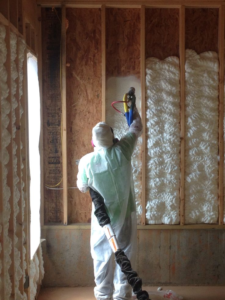Residential painters play a vital role in enhancing the aesthetics of living spaces. They also assist homeowners in maximizing value from their painting projects.

A fresh paint job can transform an ordinary living space into a personalized retreat. The following are some of the key benefits of working with a residential painting company. Contact Gold Lion Painting Inc for professional help.
Painting your home can be a very cost-effective way to make some much-needed improvements. However, achieving the perfect balance between affordability and outstanding results can be tricky. It’s important to keep in mind that a quality paint job can save you money in the long run as it will last longer than an inferior one.
The cost of a residential paint project can vary greatly, depending on the size and complexity of your space. It also depends on whether you’re looking to refresh a single room, multiple rooms or even the entire interior or exterior of your house. In addition, the materials used can significantly affect the overall expense. For example, eco-friendly paints are a great choice for improving indoor air quality but usually come with a premium in price.
Labor costs are another factor that determines the final cost of your painting project. This includes the cost of hiring a professional painting service, the preparation and cleaning work required, as well as any additional services that may be needed (e.g. power washing). The location of your home can also impact painting prices. Urban areas typically see higher rates compared to rural locations.
If you’re able to paint your home yourself, you can dramatically decrease the initial cost of your project. The key is to plan ahead and choose your colors carefully. Choosing a few primary colors for your home will help to reduce the number of paints needed, which in turn will cut costs.
Another great way to save on painting costs is by utilizing leftover paint from a previous project. You can also cut costs by using a single color for an entire room. It’s a good idea to consult an interior design specialist or check out galleries of painted homes before selecting your colors.
When painting your home, it’s a good idea to fix any damaged areas before moving forward with the project. This will ensure that any repairs are made properly, and it will avoid the need for costly touch-ups down the road. It’s also a good idea to hire a professional for your residential painting project. Their experience and expertise can save you time and money in the long run, as well as provide superior results that will add value to your home.
Aesthetics
A well-executed paint job accentuates your home’s architectural details and enhances curb appeal, increasing its market value. It also protects your investment, protecting surfaces from environmental damage and minimizing the effects of wear and tear. A fresh coat of paint can also boost your mental health, improving concentration and mood.
The interior and exterior of your home reflects your personality, making it important to express yourself through the color palette you choose. Professional house painters are experienced in color selection, and can work with you to achieve your vision for your home’s interior and exterior. They can advise you on color trends and market research, so you can feel confident that your choice is a smart one for both the short- and long-term.
Residential painting focuses on painting private living spaces, typically homes, townhomes, or condominiums. While some elements of this project overlap with commercial painting, residential painting projects place more emphasis on aesthetics and personalization. Homeowners often prefer to hire residential painting contractors who have experience working with different types of homes and who can accommodate their specific preferences.
Homeowners often want to incorporate their own aesthetic into their home’s design through paint, allowing them to customize living spaces and create a unique atmosphere that aligns with their personalities. From calming hues in bedrooms to vibrant colors in living rooms, the right color palette can transform rooms into captivating environments.
Many homeowners prioritize residential painting to ensure their living spaces are well-protected from environmental damage, and to maintain the integrity of their property. They may also seek to improve their home’s appearance and increase its resale value through strategic color upgrades.
The residential painting industry is constantly evolving, and it’s important for professional painters to stay up-to-date on current trends and techniques to provide the best possible service. From preferred colors to market research, the experts at VanDerKolk Painting keep their finger on the pulse of the industry to ensure they’re providing clients with high-quality services that reflect their needs and desires.
Curb Appeal
Curb appeal is a first impression that can make or break your house’s value, and it’s something every homeowner should aim for. A home with good curb appeal shows potential buyers that it has been well-maintained, and it may inspire them to want to see what’s inside. In addition, a high level of curb appeal may encourage homebuyers to offer a higher price than would otherwise be the case.
One of the best ways to add curb appeal is through landscaping. Overgrown bushes and weeds can make your home look unkempt, while a well-maintained garden and lawn can give it a fresh, inviting appearance. Another simple way to improve your home’s curb appeal is by adding window boxes. These are a great way to add color and charm to your front yard, and they can be made from a variety of materials, including copper or iron for a traditional feel, or painted wood for a more cottage-style look. Choose flowers or plants that are well-suited to the local climate and your home’s color scheme.
Adding a touch of sophistication to your home’s exterior can also help boost its curb appeal. A few small upgrades can go a long way, such as painting your front door a brighter shade or replacing outdated light fixtures or even your mailbox. These improvements can instantly update your home’s look and increase its overall value.
It’s important to note that, while curb appeal is an essential part of selling a home, it doesn’t necessarily have to be expensive. In fact, it’s often more cost-effective to focus on the basics rather than attempting to make drastic changes.
A quality residential painter will be able to work within your budget to create a beautiful and personalized living space. They’ll be able to advise you on the best colors and styles to enhance your property, and they can work around your schedule to ensure that the project is completed quickly and efficiently.
Commercial painting and residential painting have some similarities, but the former focuses on larger spaces and has a more rigid structure. It’s also more common for businesses to have multiple projects underway at the same time, which can impact product management and scheduling.
Safety
Residential painting projects can involve hazardous materials, and it’s essential to adhere to strict safety standards. Professional painters take steps to mitigate risks, including ensuring adequate ventilation, covering furniture and belongings, and using a variety of tools to reach high areas. They also prioritize the use of ladders and scaffolding that are properly set up, inspected, and secure to prevent falls. They should always maintain three points of contact to support themselves when climbing and must wear appropriate safety gear to avoid injury.
Tenants can play an important role in ensuring apartment painting is safe, by keeping themselves informed and taking steps to minimize exposure to fumes. For example, choosing low-VOC paints helps to reduce harmful fumes that can irritate the eyes and respiratory tract. They can also minimize the time they spend in the apartment while paint is drying, and use fans to improve ventilation when possible. In the event of any concerns, they should communicate these to their property manager.
Commercial painting contractors must follow stricter safety regulations than residential painters, as their work takes place in larger environments and there are often more people present. They must be licensed, insured, and comply with industry safety standards to operate legally and to ensure their employees’ safety. They also must make sure their crews have access to proper training and equipment, as well as follow best practices to keep everyone safe.
The equipment used by a commercial painting contractor is typically different from that of a residential one, although both can include items like step ladders and drop cloths. Quality commercial painters will know how to properly handle and use their tools, as they must be familiar with the wide range of different types of paint and finishes. They will also have more experience working in large spaces, which can lead to a more efficient work process and fewer errors. This will result in a higher quality finish and lower costs. They may also have a greater understanding of the various factors that influence the success of a particular project, such as weather conditions and lighting.








